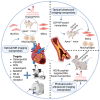Engineering molecular nanoprobes to target early atherosclerosis: Precise diagnostic tools and promising therapeutic carriers
- PMID: 37064609
- PMCID: PMC10093416
- DOI: 10.7150/ntno.82654
Engineering molecular nanoprobes to target early atherosclerosis: Precise diagnostic tools and promising therapeutic carriers
Abstract
Atherosclerosis, an inflammation-driven chronic blood vessel disease, is a major contributor to devastating cardiovascular events, bringing serious social and economic burdens. Currently, non-invasive diagnostic and therapeutic techniques in combination with novel nanosized materials as well as established molecular targets are under active investigation to develop integrated molecular imaging approaches, precisely visualizing and/or even effectively reversing early-stage plaques. Besides, mechanistic investigation in the past decades provides many potent candidates extensively involved in the initiation and progression of atherosclerosis. Recent hotly-studied imaging nanoprobes for detecting early plaques mainly including optical nanoprobes, photoacoustic nanoprobes, magnetic resonance nanoprobes, positron emission tomography nanoprobes, and other dual- and multi-modality imaging nanoprobes, have been proven to be surface functionalized with important molecular targets, which occupy tailored physical and biological properties for atherogenesis. Of note, these engineering nanoprobes provide long blood-pool residence and specific molecular targeting, which allows efficient recognition of early-stage atherosclerotic plaques and thereby function as a novel type of precise diagnostic tools as well as potential therapeutic carriers of anti-atherosclerosis drugs. There have been no available nanoprobes applied in the clinics so far, although many newly emerged nanoprobes, as exemplified by aggregation-induced emission nanoprobes and TiO2 nanoprobes, have been tested for cell lines in vitro and atherogenic animal models in vivo, achieving good experimental effects. Therefore, there is an urgent call to translate these preclinical results for nanoprobes into clinical trials. For this reason, this review aims to give an overview of currently investigated nanoprobes in the context of atherosclerosis, summarize relevant published studies showing applications of different kinds of formulated nanoprobes in early detection and reverse of plaques, discuss recent advances and some limitations thereof, and provide some insights into the development of the new generation of more precise and efficient molecular nanoprobes, with a critical property of specifically targeting early atherosclerosis.
Keywords: Atherosclerosis; Dual-modality; Early-stage; Molecular imaging; Multi-modality; Nanoprobes; Precise diagnosis; Single-modality; Therapeutics.
© The author(s).
Conflict of interest statement
Competing Interests: The authors have declared that no competing interest exists.
Figures


Similar articles
-
Molecular imaging nanoprobes and their applications in atherosclerosis diagnosis.Theranostics. 2024 Aug 12;14(12):4747-4772. doi: 10.7150/thno.96037. eCollection 2024. Theranostics. 2024. PMID: 39239513 Free PMC article. Review.
-
Recent advances in molecular imaging of atherosclerotic plaques and thrombosis.Nanoscale. 2020 Apr 21;12(15):8040-8064. doi: 10.1039/d0nr00599a. Epub 2020 Apr 2. Nanoscale. 2020. PMID: 32239038 Review.
-
Highly Bright AIE Nanoparticles by Regulating the Substituent of Rhodanine for Precise Early Detection of Atherosclerosis and Drug Screening.Adv Mater. 2022 Mar;34(9):e2106994. doi: 10.1002/adma.202106994. Epub 2022 Jan 23. Adv Mater. 2022. PMID: 34921573
-
Molecular imaging of the extracellular matrix in the context of atherosclerosis.Adv Drug Deliv Rev. 2017 Apr;113:49-60. doi: 10.1016/j.addr.2016.09.005. Epub 2016 Sep 14. Adv Drug Deliv Rev. 2017. PMID: 27639968 Review.
-
Molecular Imaging of Inflammation in a Mouse Model of Atherosclerosis Using a Zirconium-89-Labeled Probe.Int J Nanomedicine. 2020 Aug 14;15:6137-6152. doi: 10.2147/IJN.S256395. eCollection 2020. Int J Nanomedicine. 2020. PMID: 32884268 Free PMC article.
Cited by
-
Molecular Imaging of Fibroblast Activation in Rabbit Atherosclerotic Plaques: a Preclinical PET/CT Study.Mol Imaging Biol. 2024 Aug;26(4):680-692. doi: 10.1007/s11307-024-01919-9. Epub 2024 Apr 25. Mol Imaging Biol. 2024. PMID: 38664355
-
Diagnostics of atherosclerosis: Overview of the existing methods.Front Cardiovasc Med. 2023 May 9;10:1134097. doi: 10.3389/fcvm.2023.1134097. eCollection 2023. Front Cardiovasc Med. 2023. PMID: 37229223 Free PMC article. Review.
-
Molecular imaging nanoprobes and their applications in atherosclerosis diagnosis.Theranostics. 2024 Aug 12;14(12):4747-4772. doi: 10.7150/thno.96037. eCollection 2024. Theranostics. 2024. PMID: 39239513 Free PMC article. Review.
-
Revealing tumor cells and tissues with high selectivity through folic acid-targeted nanofluorescence probes responsive to acidic microenvironments.Front Oncol. 2024 Jun 12;14:1404148. doi: 10.3389/fonc.2024.1404148. eCollection 2024. Front Oncol. 2024. PMID: 38933449 Free PMC article.
-
Novel Anti-Inflammatory Therapies in Coronary Artery Disease and Acute Coronary Syndromes.Life (Basel). 2023 Jul 31;13(8):1669. doi: 10.3390/life13081669. Life (Basel). 2023. PMID: 37629526 Free PMC article. Review.
References
-
- Speer T, Dimmeler S, Schunk SJ, Fliser D, Ridker PM. Targeting innate immunity-driven inflammation in CKD and cardiovascular disease. Nat Rev Nephrol. 2022. - PubMed
-
- Poredoš P, Cífková R, Marie Maier JA, Nemcsik J, Šabovič M, Jug B. et al. Preclinical atherosclerosis and cardiovascular events: Do we have a consensus about the role of preclinical atherosclerosis in the prediction of cardiovascular events? Atherosclerosis. 2022;348:25–35. - PubMed
Publication types
MeSH terms
LinkOut - more resources
Full Text Sources
Medical
Miscellaneous

